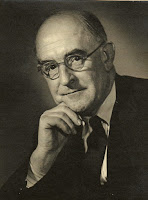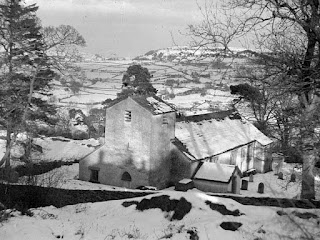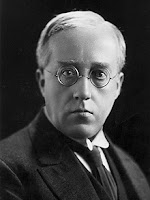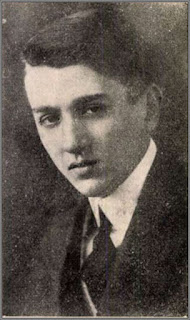Best British Symphonies: 2. "Scenic" Symphonies
Sir Hamilton Harty - "Irish Symphony"; Edward German - "Norwich Symphony"; Cecil Armstron Gibbs - "Westmoreland Symphony"; Sir John Blackwood McEwen - "A Solway Symphony"; Gustav Holst - "Cotswolds Symphony"
Many symphonies often feature depictive titles - Mozart's "Jupiter", Haydn's "Drumroll" or Beethoven's "Pastoral" being amongst the earliest and most famous examples. Many such titles refer to places, countries or cities - Mendelssohn's "Italian", Schumann's "Rhenish" or Dvorak's "From the New World" to name but a few. Not least due to their picturesque landscape and their ancient history, the British Isles have inspired many of their own composers to dedicate some of their greatest symphonies to a specific, often scenic location.***
Best known as the conductor of Manchester's Hallé Orchestra, Sir Hamilton Harty's (1879 - 1941) compositions are all worth exploring. In a tribute to his native country, the "Irish Symphony" (1904, revised 1924) captures the sound of the landscape in every one of its four movements: 1. On the Shores of Lough Neagh (Allegro molto) - 2. The Fair-Day (Vivace ma non troppo presto) - 3. In the Antrim Hills (Lento) - 4. The Twelfth Night (Con molto brio). In each of the movements the composer quotes one or more traditional Irish folk tunes. The overall musical language is otherwise not much different from its time, in the legacy of Stanford and Sullivan, but - as in most of Harty's works - convinces with its freshness of musical invention and a brilliant orchestration which has gone beyond the Germanic roots to which his predecessors had remained indebted.
The Symphony is said to have some autobiographical connections to Harty's own youth in Ulster in the North of Ireland (as it was known before the partition of Ireland with the introduction of Home Rule in the North). For a detailed analysis of the work and other articles on the composer visit his page on British Classical Music: The Land of Lost Content. Available recordings are by the Ulster Orchestra under Bryden Thomson and by the National Symphony Orchestra of Ireland under Proinssías Ó'Duinn.
***
Edward German's (1862 - 1936) Symphony No. 2 in A minor "Norwich" actually derived its tile from the Norwich Festival for which it was composed in 1893. The composer was in fact of Welsh ancestry (the name "German" - his first name rather than his surname, Jones - being an Anglicisation of an old Welsh name) born in Shropshire, and the reason his symphony was included in this catalogue is due to German's overall contribution to the quintessential English as well as Welsh music of the late Victorian and Edwardian age, making it a firm favourite of Sir Edward Elgar and Sir John Barbirolli. German's greatest achievements in form of recognition, however, lie in the then popular genre of Light Music, such as his operettas ("Merrie England", "Tom Jones") and concert pieces ("Welsh Rhapsody").
The "Norwich" is traditional in four movements, but it steps away somewhat from the so dubbed "Olde English" style of his more popular works. In its calmness and control of emotional output it is far more akin to the future Elgar than any of the previous lighter works, and it easily conjures up associations with the English landscape paintings of John Constable or the novels of Thomas Hardy.
The symphony has been recorded by the National Symphony Orchestra of Ireland under Andrew Penny and with the BBC Concert Orchestra under John Wilson.
***
In contrast to the "Norwich", the Symphony No. 3 in B flat major op. 104 "Westmorland" by Cecil Armstrong Gibbs (1889 - 1960) provides a detailed account of one of Northern England's arguably most beautiful landscapes. Anybody travelling on the West Coast mainline or on a drive up to Scotland would know the area in question, between Kendal and Penrith, with the Lake District National Park to the west and Westmorland and the Eden valley to the east. Although a native of Chelmsford, Essex, Gibbs loved the solitude of the area's fells and pastures very much and he and his wife were living there - following the death of their son - during the time of writing the symphony in 1944.
 |
| C. Armstrong Gibbs |
All of the four movements bear evocative subtitles: 1. Moderato (I will lift up mine eyes) - 2. Lento (Cartmel Fell) - 3. Scherzo, vivace con fuoco (Weathers) - 4. With Complete Serenity (The Lake). With exception of the Scherzo, the music is mainly subdued, at times even sombre and has very little in terms of symphonic grandeur one would expect, for instance, from Elgar's masterpieces or of the dramatic development seen in many contemporary pieces of this genre. It seems genuinely inspired by the nature and countryside it portrays, and leaves the listener with the humble sense of fulfilment which he may otherwise gain from a long, solitary ramble through this remote corner of England.
The "Westmorland" has been recorded by the National Symphony Orchestra of Ireland under Andrew Penny.
 |
| Cartmel Fell & church |
***
Scotland, of course, is full of natural beauty. No wonder that Scottish composer John Blackwood McEwen (1868 - 1948) has dedicated his Symphony in C sharp minor (1911) to the "Solway", the firth separating north western England from Dumfries and Galloway in Scotland's south west.
Known during his lifetime for his academic achievements - when he was a teacher and later principal at the Royal Academy of Music -, he is nowadays also being rediscovered as a composer of fine late romantic orchestral and chamber music, including 19 string quartets. His "Solway" Symphony therefore does not disappoint in its rugged moods which are as changeable as the Scottish weather. The symphony's three movements all are given inscriptions: 1. Spring Tide, Allegro moderato - 2. Moonlight, Molto tranquillo - 3. The Sou'west Wind, Vivace. The music shows some reminiscence of Bax (in a way McEwen's "Irish" counterpart*), but also of Sibelius, yet without any folksiness whatsoever. In his use of heavy brass some people see an influence of Bruckner or Wagner, but the drama in the "Solway" is first and foremost inspired by the Scottish nature and scenery.
At present, there is only one recording available with the London Philharmonic under Alasdair Mitchell.
***
Gustav Holst (1874 - 1934) is not necessarily known as a symphonist, unless one considers his world famous "The Planets" op. 34 (1914 - 16) - technically a suite - for their 'symphonic' dimensions. His Symphony in F major op. 8 "The Cotswolds" (1899 - 1900) is indeed a work of his youth, and for this lacks much of the qualities of the later operas, choral and orchestral pieces, with their references to the English Folk Song movement and to Indian spirituality as main sources of influence.
 |
| Gustav Holst |
In his early symphony, however, he - as a son of the spa town of Cheltenham - intended to pay tribute to his native Cotswolds. Whilst the opening Allegro con brio, Scherzo and Finale are, despite their peaceful pastoral character, altogether fairly unremarkable for their academic traditionalism, it is due to the utterly moving second movement that makes this symphony worth listening to: Elegy (In memoriam William Morris). It shows the young, middle class man's admiration - who earned a living as a trombonist and later as a teacher - for one of the founders of British socialism whose artist commune at Kelmscott Manor was situated on the very outskirts of the Cotswolds on the banks of the river Thames across into Oxfordshire.
The "Cotswolds" Symphony became available in a recording for the Classico label by the Munich Symphony Orchestra under Douglas Bostock, but has been joined by Chandos with the BBC Philharmonic under Sir Andrew Davis and by Naxos with the Ulster Orchestra under JoAnn Falletta.
_____
* Arnold Bax (1883 - 1953), although English, became fascinated with Ireland and the Celtic culture. He lived in Dublin in the years before the First World War.



Comments
Post a Comment